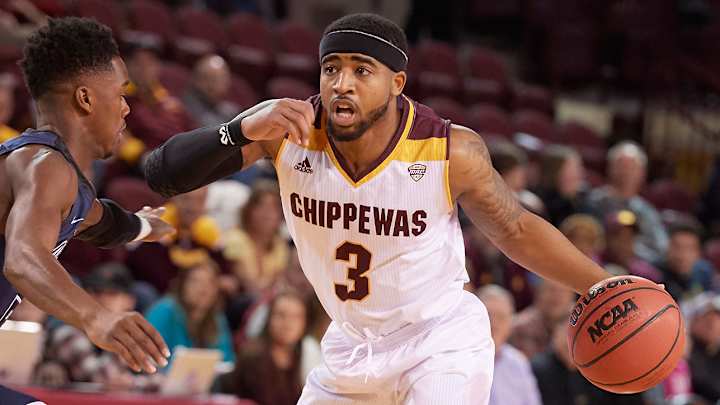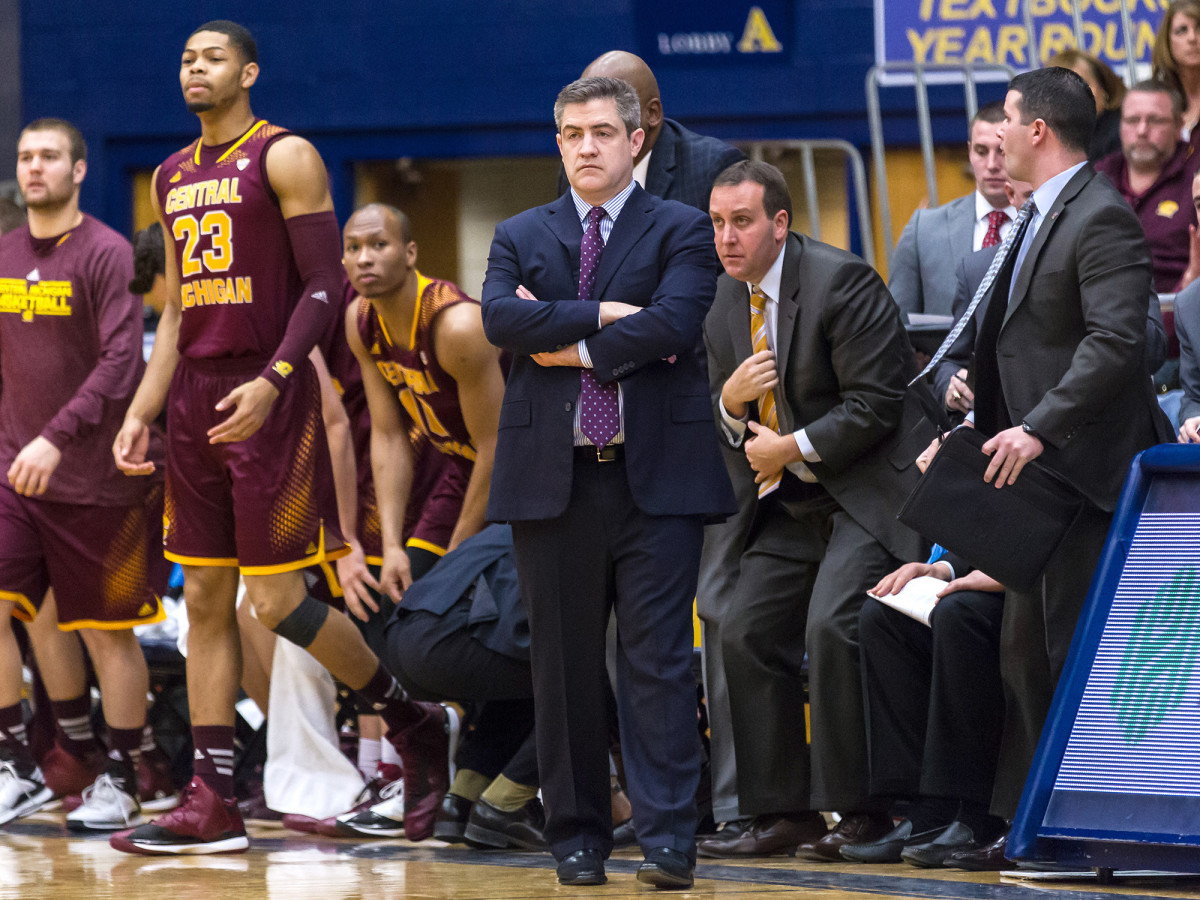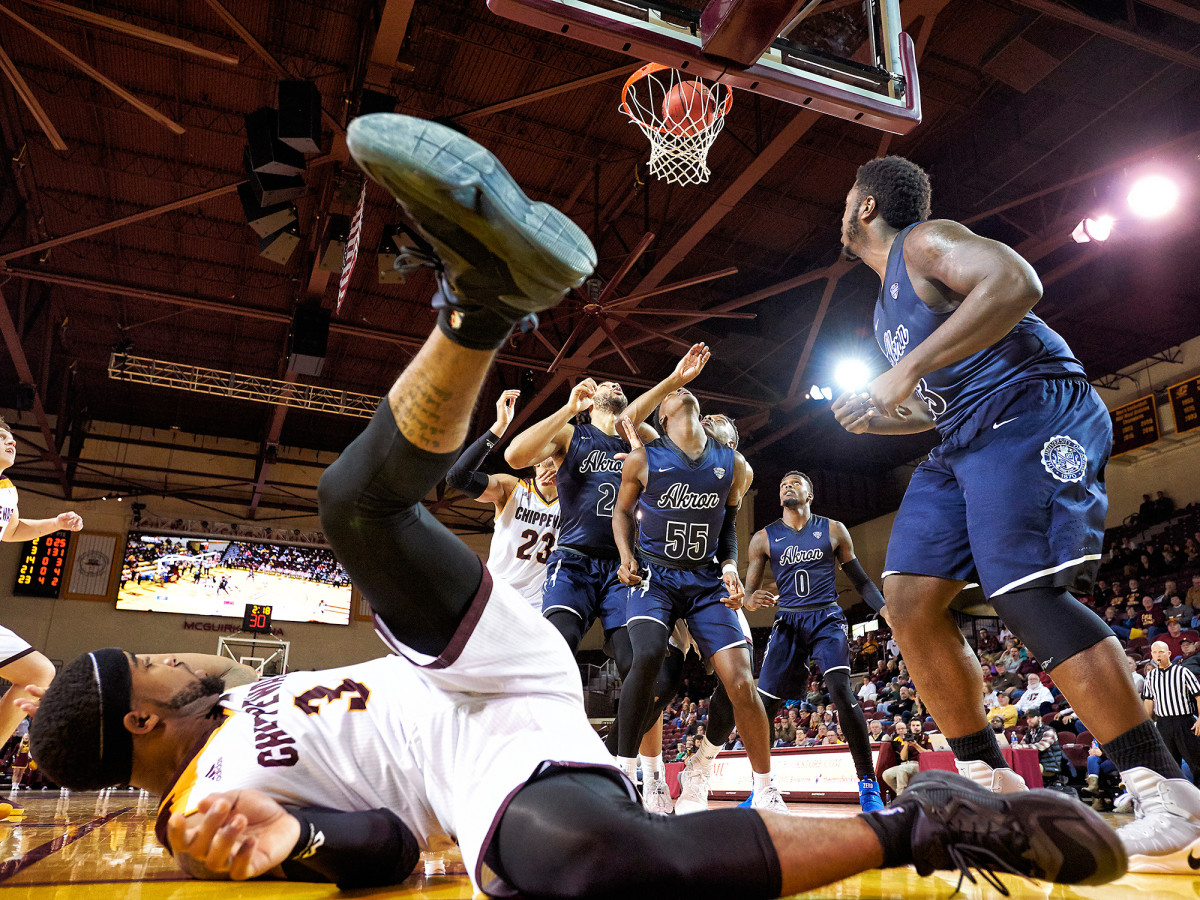Keenesanity: D-I scoring leader Marcus Keene is 5' 9" and fearless

His story originally appeared in the Jan. 30, 2017 issue of Sports Illustrated. Subscribe to the magazine here.
There’s a catch to all of this attention. Marcus Keene knows that now. It’s nice to scroll through a slew of laudatory tweets and Instagram posts after another scoring eruption, to see your name on ESPN and have kids waiting for your autograph. But excellence begets expectation, even for a 5' 9" former zero-star recruit, and after those so-called off nights, when the Central Michigan junior point guard puts up only, say, 23 points, the social media peanut gallery speaks up. These critics care not that Keene was doubled on ball screens and collapsed upon by entire defenses, or that his assist rate ranks 28th nationally. They want to know why the mid-major sensation flirting with Division I’s first 30-points-per-game season in 20 years did not again clear that august threshold. They want to know why he failed them.
“That’s what you see with famous people—people talk bad about them in their comments,” Keene says. His irrepressible grin cedes briefly to bemusement. “Now it’s happening to me.”
In a season defined by Keene’s sheer volume of points—30.2 per game at week’s end, including 50 against Miami (Ohio) on Jan. 21—three in particular thrust him into the national consciousness. On Dec. 6 the Chippewas led Green Bay by six with 2:58 remaining. With about 20 seconds on the shot clock, Keene dribbled leisurely across the court, right to left, 10 feet beyond the arc. When he neared the left wing, he casually bounced the ball from his right hand to his left behind his back—also performing a wholly superfluous counterclockwise spin—then pulled up in rhythm to fire a jumper.
The shot had barely splashed through the net before it went viral. SB Nation proclaimed it “the most arrogant 3 of the year.” The Big Lead called it “extremely cocky.” Keene’s performance—40 points, 11 assists, seven rebounds—led the late-night edition of SportsCenter, which further stoked online buzz by misspelling Keene’s last name and mistakenly displaying a photo of teammate Braylon Rayson. ESPN talking head Stephen A. Smith sent Keene a congratulatory tweet, leaving the loyal First Take viewer awestruck. Asked to explain his impromptu flourish, Keene shrugs. “I was just hoopin’, bruh.”
Bracket Watch: Louisville within striking distance of the top line
The play was a distillation of Keene himself: confident but justified, outlandish but ultraproductive, defiant with a smile. Hooping has been his raison d’être since he was a toddler lugging a dusty basketball into his bath. With both parents in the Air Force, Keene showed self-discipline as early as grade school—morning runs down his street in San Antonio, scheduled meals, shot-counting shootarounds. He avoided candy and chugged milk. When he read that his asthma medication could delay growth, he squeezed his inhaler into the air to fool his parents into thinking he’d used it.
Keene stood only 5' 2" in ninth grade, but he could bench-press 160 pounds, and he was tough. Two years later, when one of his teeth was knocked out during an AAU tournament, he handed the incisor to his mother in the stands, returned to the court and helped his team win the title. As a junior at Earl Warren High he was told his season was over after breaking an ankle. Instead he tried Airrosti therapy, a painful, nontraditional form of rehab that uses intense pressure to break up scar tissue. He screamed through a towel during treatment, and returned to hit back-to-back game-winners during the playoffs, a run the San Antonio Express-News dubbed “Keenesanity.”
But few college recruiters were impressed. Entering his senior season Keene reluctantly accepted his lone D-I scholarship offer, from Youngstown State. Indignant, he would size up more highly touted Texas recruits: I could play against him, I could play against him. . . .
“If you’re not over 6’4”, then I feel like you’re the same size as me,” Keene says. “Now my game has reached my confidence.” All it took was a change of scenery and a union with a new coach and an old opponent.

In many ways Keno Davis was destined for the bench. “I wasn’t an athlete,” the fifth-year coach says with a laugh. But he lived and breathed basketball, growing up immersed in the programs his father, Tom, coached at Lafayette, Boston College and Stanford. By the time Keno was college age in the early 1990s, Tom was coaching at Iowa, where his son joined the Hawkeyes as an undergraduate assistant, bouncing between coaches’ meetings and his duties as a practice player. But Keno often found himself challenging conventional wisdom. At coaching clinics he would ask, What are the numbers to back that up? When it came time for Keno to run his own team, Tom told his son, “You have to do what you believe in.”
In 2007, at 35, Keno got his chance, taking over at Drake when Tom retired. Keno inherited a team equipped to play his father’s up-tempo, pressing style; he also had a fleet of capable outside shooters. He had long been enamored with both per-possession efficiency stats and outlier offenses like those of the Hank Gathers–era Loyola Marymount team and Mike D’Antoni’s Phoenix Suns. So Davis’s first Bulldogs squad underwent an extreme makeover, upping the share of field goals it took from beyond the arc from 32.5% (195th nationally) to 46.1% (10th). A team picked to come in ninth in the Missouri Valley finished 14th in the country. Davis was named national coach of the year. “It sold me,” he says, “that this is something that I wanna try to build my teams on.”
That spring Davis decamped to Providence. But in three seasons there his teams did not shoot threes as often (never more than 35.8% of their shot attempts) nor as well (never better than 33.0%). After going 46–50, he was fired. Davis spent the 2011–12 season working as a Big Ten Network analyst, scouting teams for broadcasts and tinkering with his coaching philosophy. The need to describe teams concisely to a TV audience provided a lesson. “The programs that were successful,” Davis says, “had an identity.”
When Davis arrived in Mount Pleasant in April 2012, he set about building one for the Chippewas, who had just two winning seasons in the previous 24 years. With only three returning players, he sought to fill his roster with recruits adept at the game’s most valuable shot—the three-pointer—and at pushing the pace. “It was my belief,” says Davis, “that if we could get an up-tempo, running, exciting style, that we could put butts in the seats and it would be enticing to recruits.” In 2012–13, Central Michigan took 45.4% of its shots from deep, the most in the nation. Two seasons later, with threes making up 48.1% of their shots, the Chippewas won 23 games, second most in school history. #3MU was born.
Power Rankings: The best jerseys, throwbacks and alternates in college hoops
During that 2014–15 season Central Michigan gave up 24 points on 15 shots to a sophomore guard during a November win over Youngstown State. After an up-and-down freshman season—including a suspension for punching and breaking the nose of a 6’4” teammate during practice—Keene was a valuable starter for the Penguins, averaging 15.6 points. But he was dissatisfied with their performance (dead last in the Horizon) and less than happy with his role (spot-up two guard). He wanted to play the point, and to play it elsewhere. At the end of the season he announced he would transfer.
Central Michigan was interested in adding another quick, sharpshooting guard to play with Rayson, and the Dallas native proved an asset in luring him. Rayson knew Keene from the AAU circuit, where the remarkably similar prospects—5’9”, self-assured, fearless—were naturally pitted against each other in the cutthroat recruiting game.
“When we first started playing against each other, it was like, He sucks, I’m gonna kill him,” recalls Rayson. The turning point came after an AAU game in which Rayson followed a Keene miss by hitting a fadeaway game-winner while tumbling into a row of courtside folding chairs. Afterward Keene and Rayson chatted at the concession stand. Following their collegiate duel Rayson raved about playing in Davis’s offense. Chippewas assistant Jeff Smith called Keene to gauge his interest. “He said, ‘How would you feel about playing with Braylon Rayson?’” recalls Keene. “I was like, Well, how do y’all feel about playing with two 5' 9" guards?”
Chippewas fans rejoiced, christening their future backcourt the Texas Two-Step. As a scout-teamer while redshirting last season due to NCAA transfer rules, Keene added 15 pounds of muscle and gave the starters fits, at one point firing off 37 points in a scrimmage. “We couldn’t do nothing with him,” Rayson says. “It was to the point where we just had to live with it.”
But the duo knew the best was yet to come. “We always said that one of us was gonna lead the country in scoring,” Keene says. “We just didn’t know which one of us it was gonna be.”

The social media maelstrom is not without its perks. For months Keene told everyone about his Instagram goal: to be featured in a post by @famouslos32, a wise-cracking chronicler of basketball’s most like-worthy moves. With every crossover and off-balance layup Keene hoped to finally have his moment. Then, on the night of his spinaround three against Green Bay, Famous Los complied, splicing replays of the bucket with his own enthralled, wide-eyed commentary. “I wanted to do that in college,” he told his more than 800,000 followers. “Coach would’ve killed me. Coach let you get off like that, boy?!”
This season Davis’s leash is indeed looser than ever. The Chippewas rank sixth nationally in tempo and attempt 52.3% of their field goals from beyond the arc (second), resulting in an average of 34.6 three-point tries per game. It’s an approach beloved by players both current (Davis “lets you be you,” says Rayson, who averages 19.4 points) and future. “One [recruiting] trip down to Texas, everyone knew who we were,” says Davis. “Three years ago they only knew Central Michigan was in central Michigan.”
The Chippewas have won the MAC’s West Division two years running, but they have yet to earn an NCAA tournament berth. Whether they can make their third appearance in 40 seasons—the other two coming when future NBA players Dan Majerle (1987) and Chris Kaman (2003) roamed the campus—will depend largely on one as-yet unmentioned aspect of the game: defense. Thanks in part to their freewheeling nature and all-shooters-on-deck lineups, Central Michigan ranks just 335th in defensive efficiency, which explains its 15–8 record (5–5 in the MAC). To play their way into March Madness, the Chippewas will need to defend at least a little bit. Should they get a ticket to the Big Dance, however, they are the kind of bombs-away opponent no team wants to face.
“For an NCAA tournament game against Duke, Georgetown, anyone like that, I’ll trade all of it,” Keene says. “I just wanna play in that national spotlight one time.” He is ready, good or bad, for whatever attention he might attract once he gets there.
